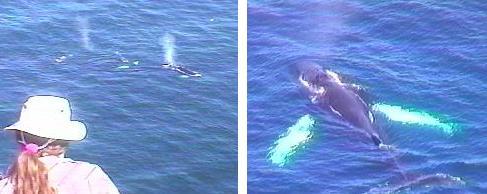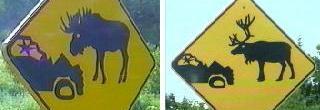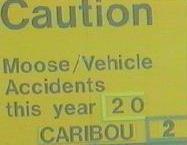NEWFOUNDLAND & LABRADOR Jim Belote (e-mail: jbelote@d.umn.edu)(with Linda S. Belote)
"WRETCHED. SO STANDS Newfoundland. A barren rock-strewn coast, a cruel, devouring sea, dreadful fog loom. Belligerent winds that pummel all life into submission. A melancholy wasteland of interminable forests and bogs.
And yet, she beckons." (Beckel 1999: opening lines)
"This place, she thought, this rock, six thousand miles of coast blind-wrapped in fog. Sunkers under wrinkled water, boats threading tickles between ice-scabbed cliffs. Tundra and barrens, a land of stunted spruce men cut and drew away." (Proulx 1993:32)
"I cried and cried when I first came to Newfoundland. . . . There was ice in the puddles and snow in the woods. There was nothing green, just sheer rock. It was such a desolate place. . . . Yet it's a calm place to live. At times I feel isolated, but mostly it just lets me be myself." (Shauna Steffla, quoted in Momatiuk & Eastcott 1998:54)
In 1610, John Guy starts the first formal settlement at Cupids, and is fooled by the fluke of two successive mild winters into thinking he would like to live there. He is convinced otherwise by the less-anomalous winter of 1613, after which he returns home and for the rest of his life wakes up screaming in the middle of the night, refusing to go back to sleep until his wife assures him he no longer lives in Newfoundland." (Johnston 1998:67)
"Two St. John's men were battling their way up Prescott Street one day in June in the teeth of a howling gale and a miserable "dwoi" (or snow storm). One looked plaintively at the other and said 'John Cabot got ten pounds for discovering this God forsaken island--he should have gotten TEN YEARS.' " (Sullivan 1997:16)
"Newfoundland: a large island but not a fruitful one, and in its geographical features not an hospitable one. An isolated, self-enclosed triangle, each of its coastlines like a graph gone mad, and the interior a wilderness, in its primitive state more suited to the violence of the hunter than to the patient, coaxing arts of agricultural man. And around this harsh land nothing but salt water, the all-encompassing ocean--another hunting ground for man in search of his daily bread." (Janes 1992:11)
"COMPLAINTS IS MANY & VARIOUS, BUT THE ODD DIVIL LIKES IT" ... (Moyles 1975: book title)
"THE LAND GOD GAVE TO CAIN" (Innes 1958: book title)
"When blinding storm gusts fret thy shore, and wild waves lash thy strand, Through spindrift swirl and tempest roar, We love thee wind-swept land We love thee, we love thee, We love thee, wind swept land." (From Ode To Newfoundland, considered the "national anthem" of the province. See West [1991:37])




For more Newfoundland photos click here
BOOKS,etc.
Why this listing?
Beckel, Annamarie
1999 ALL GONE WIDDUN. St. John's:Breakwater Books, Ltd.
Written by a Wisconsin native who works on the Lac du
Flambeau Ojibwe Indian Reservation, this moving historical
novel relates the story of Shanawdithit, the last known
surviving Beothuk (see Marshall, below) and William Epps
Cormack, who spent years looking for her people in the early
1800s. Based on thorough research, the novel takes us from
the wild, almost unknown (to Europeans, of course) interior
of Newfoundland, to "high society" in St. John's, to museums
in the British Isles (to which, shamefully, the skulls of the
three last known Beothuks, Shanawdithit, Demasduit and
Nonosabasut were taken. Shanawdithit's skull was destroyed
in London as a consequence of WWII bombing. On November 25
1999, Linda Belote and Nicole Bourque viewed the skulls of
Demasduit and Nonosabasut where they are stored in the Mammals
and Birds section of the Royal Museum of Scotland in Edinburgh.).
Brown, Cassie
1972 DEATH ON THE ICE: THE GREAT NEWFOUNDLAND SEALING DISASTER
OF 1914. Toronto: Doubleday Canada.
"Every year for more than a century Newfoundland men and boys
went out in ships to the most dangerous and brutal adventure
that has ever been called an industry--the seal hunt. More
than a thousand of them died when their ships sank, crushed
like egshells by colliding ice fields, or exploded, or failed
to pick them up from drifting floes ..." (from the Foreword)
This is a detailed account of one seal-hunt disaster.
Chantraine, Pol
1993 THE LAST CODFISH: LIFE AND DEATH OF THE NEWFOUNDLAND WAY
OF LIFE. Montreal: Robert Davies Publishing.
Coleman-Sadd, Stephen, and Susan A. Scott
1994 NEWFOUNDLAND & LABRADOR: TRAVELLER'S GUIDE TO THE GEOLOGY
AND GUIDEBOOK TO STOPS OF INTEREST. St. John's(?):Canada-
Newfoundland Cooperation Agreement on Mineral Development.
Includes 1:1,000,000 map of Newfoundland and 1:2,000,000
map of Labrador.
Dwyer, Michael J.
1998 OVER THE SIDE, MICKEY: A SEALER'S FIRST HAND ACCOUNT OF THE
NEWFOUNDLAND SEAL HUNT. Halifax: Nimbus.
And this all happened in the late 20th century !
Felt, Lawrence F., and Peter R. Sinclair, eds.
1995 LIVING ON THE EDGE ON THE GREAT NORTHERN PENINSULA OF
NEWFOUNDLAND. St. John's: Institute of Social and Economic Research,
Memorial University of Newfoundland.
A collection of articles on the Great Northern Peninsula ranging
in topics from the fishery, to the roles of women, to the importance
of home production activities (including roadside gardens).
Harris, Michael
1998 LAMENT FOR AN OCEAN. THE COLLAPSE OF THE ATLANTIC COD FISHERY:
A TRUE CRIME STORY. Toronto: McClelland & Stewart Inc.
A detailed account primarily of the political context of the crash
of the cod fishery.
Innes, Hammond
1958 THE LAND GOD GAVE TO CAIN. Glasgow: Fontana Books.
A mystery novel set in Labrador.
Janes, Percy
1992 HOUSE OF HATE. St. John's: Breakwater.
Johnston, Wayne
1990 THE DIVINE RYANS. New York: Broadway Books.
About a weird and wonderful Catholic boyhood in St. John's. The
Divine Ryans has just (Fall 1999) been released as a movie.
Unfortunately for us here in Duluth, it's a Canadian production.
Maybe we'll have to make a quick trip up to Thunder Bay, eh?
Johnston, Wayne
1998 THE COLONY OF UNREQUITED DREAMS. New York: Doubleday.
A fascinating historical novel about Joey Smallwood, the best
known Newfoundlander of this century, a man who led Newfound-
land into confederation with Canada in 1949--and didn't quit
there.
Katona, Steven, Valerie Rough and David T. Richardson
1993 A FIELD GUIDE TO WHALES, PORPOISES, AND SEALS FROM
CAPE COD TO NEWFOUNDLAND. Washington: Smithsonian.
"Newfoundland's steep and forbidding coast can be a whale-
watcher's paradise, yielding sightings of humpback, finback,
minke, and pilot whales, plus several species of dolphins
(p.25)." This book is a very handy and informative guide to
the sea mammals to be encountered around Newfoundland and
Labrador.
Kelland, Otto
1984 DORIES AND DORYMEN. St. John's: Robinson-Blackmore.
Kennedy, John C.
1995 PEOPLE OF THE BAYS AND HEADLANDS: ANTHROPOLOGICAL HISTORY
AND THE FATE OF COMMUNITIES IN THE UNKNOWN LABRADOR. Toronto:
University of Toronto Press.
An interesting, scholarly account of the people of the
southeastern coast of Labrador .
Kennedy, John C.
1995 LABRADOR VILLAGE. Prospect Heights, Illnois: Waveland.
This is about the people of an isolated part of the Labrador
coast who had a tradition of moving between winter settlements
and summer settlements.(An interesting discussion of this
pattern, which was also common in other areas, has been
presented by Phillip Smith [1987, "Transhumant Europeans
Overseas: The Newfoundland Case," CURRENT ANTHROPOLOGY. Vol.28,
#2, pp. 241-250].)
Kurlansky, Mark
1997 COD: A BIOGRAPHY OF THE FISH THAT CHANGED THE WORLD. New York:
Walker and Company.
A very readable presentation of the last thousand years of the
cod fishery of the north Atlantic, and the disaster than eventually
befell it.
Marshall, Ingeborg
1996 A HISTORY AND ETHNOGRAPHY OF THE BEOTHUK. Montreal:
McGill-Queen's University Press.
The Beothuk were the main inhabitants of Newfoundland when
Europeans arrived in the 1500s. A tragedy of Newfoundland
history is that they were wiped out by Europeans by the
early 1800s. This book provides much of the information
available about them.
Martin, Cabot
1992 NO FISH AND OUR LIVES: SOME SURVIVAL NOTES FOR
NEWFOUNDLAND. St. John's: Creative Publishers.
Maryniak, Barbara
1994 A HIKING GUIDE TO THE NATIONAL PARKS & HISTORIC SITES OF
NEWFOUNDLAND. Fredericton: Goose Lane Editions.
Matthews, David Ralph
1993 CONTROLLING COMMON PROPERTY: REGULATING CANADA'S EAST COAST
FISHERY. Torono: University of Toronto Press.
A detailed analysis of how technological change, and changing
government policies (underlain, in part, by Garett Hardin's
"tragedy of the commons" thesis)towards the "common-property"
fishery, have impacted the in-shore Newfoundland fishery.
Momatiuk, Yva and John Eastcott
1998 THIS MARVELLOUS TERRIBLE PLACE: IMAGES OF NEWFOUNDLAND
AND LABRADOR. Willowdale, Ontario: Firefly Books.
Plenty of excellent photos, interesting text and, best of
all, people from Newfoundland and Labrador tell their own
stories.
Morgan, Bernice
1992 RANDOM PASSAGE. St. John's: Breakwater.
1994 WAITING FOR TIME. St. John's: Breakwater.
Read these two novels (the second is a sequel to the first)
to get a good feel for what Newfoundlanders have endured from
early settlement to the crash of the cod fishery.
Moyles, R. G.
1975 "COMPLAINTS IS MANY AND VARIOUS, BUT THE ODD DIVIL LIKES
IT": NINETEENTH CENTURY VIEWS OF NEWFOUNDLAND. Toronto: Peter
Martin Associates, Ltd.
Mowat, Farley
1970 THE BOAT WHO WOULDN'T FLOAT. New York: Bantam.
Not all Newfoundlanders are in love with Mowat or his books,
but I'm not going to get into that here. All I need say now
is that this is a funny book--and a fun read.
Murphy, Dan, Jim Price, & Kevin Redmond
1996 CANYONS, COVES AND COASTAL WATERS: CHOICE CANOE AND KAYAK
ROUTES OF NEWFOUNDLAND AND LABRADOR. St. John's: Breakwater.
Doing all the routes described could keep you busy for a
lifetime. And you would have only just begun to know the
incredible variety of waterways in the province.
Norman, Howard
1994 THE BIRD ARTIST. New York: Picador.
Why did young bird artist, Fabian, kill the lighthouse
keeper in Witless Bay, Newfoundland? Read this fascinating
novel and find out. But don't bother looking for the light-
house when you visit Witless Bay or you, like us, will be
disappointed.
Okihiro, Norman R.
1997 MOUNTIES, MOOSE, AND MOONSHINE: THE PATTERNS AND CONTEXT OF
OUTPORT CRIME. Toronto: University of Toronto Press.
Not just a study of crime and punishment in outport
Newfoundland--lots of interesting data and analysis. Okihiro
points out that "Much of the [subsistence oriented]
economic activity that provided the basis of the traditional
outport way of life has been outlawed," (p. 157) and that "One
inadvertent result of the criminalization of community-
supported traditional behaviour, then, is an increase in inter-
personal suspicion among community residents and a breakdown of
community solidarity" (p. 159)....
Proulx, E. Annie
1993 THE SHIPPING NEWS. New York: Touchstone.
Although some Newfoundlanders don't like it, I loved this
sometimes dark (especially at the beginning) and wonderful
novel. It has drawn a lot of people, including us [Thanks
Annie!], to Newfoundland. On the other hand, I can't imagine
many people being lured to Wyoming by Proulx's CLOSE RANGE:
WYOMING STORIES. So ....
Ryan, Shannon
1994 THE ICE HUNTERS: A HISTORY OF NEWFOUNDLAND SEALING TO 1914.
St. John's: Breakwater.
A thorough, detailed (and academic) examination of sealing
and its contribution to the development of settlement in
Newfoundland and its association with a rising demand for
oils in the western world. In tracing the story, this book
will take you all the way back to the ending of curfews in
late Middle-Ages northern Europe and the emergence of laws
requiring some householders and others to provide street
lights.
Story, George
1997 PEOPLE OF THE LANDWASH: ESSAYS ON NEWFOUNDLAND AND LABRADOR
(edited by Melvin Baker, Helen Peters and Shannon Ryan).
St. John's: Harry Cuff Publications Limited.
A collection of essays on language, history, "folklore" and
other topics by one of the great modern scholars of Newfoundland.
Story, G. M., W. J. Kirwin, and J. D. A. Widdowson, Eds.
1990 DICTIONARY OF NEWFOUNDLAND ENGLISH (Second edition with
Supplement). Toronto: University of Toronto Press.
How many terms are used in Newfoundland to refer to jumping
from one ice pan to another? What do you call that huge
jumble of ice piled up all along the shore in winter? Is it
OK to "twak"? What's a "butter bitch"? And what are "God
walkers"? And what does "tickle" mean in Newfoundland? And
"Pinchgut"? Can you make it through the "tuckamore"? And
what's a "bedlamer"? Would you enjoy just watching it? Or
could you eat it? Or should you wake her up before noon, or
report him to the police? Would you swear at it for growing
up too fast? If you were a bedlamer should you bring this out
in confession? And finally, which way IS up?
With 770 pages of text, this masterwork will help you increase
your word power.
And now you can get the answers to the above questions straight from
the web where the whole thing is available (buy the printed edition
anyway) at http://www.heritage.nf.ca/dictionary/default.html!!
Sullivan, Arthur M.
1995 NO STRANGERS HERE: A SIMPLIFIED GUIDE TO TRAVEL IN
NEWFOUNDLAND(Second edition). St. John's:Creative Publishers.
Szwed, John
1966 PRIVATE CULTURES AND PUBLIC IMAGERY: INTERPERSONAL RELATIONS
IN A NEWFOUNDLAND PEASANT SOCIETY. St. John's: Institute of Social
and Economic Research, Memorial University of Newfoundland.
About the rural people of the Codroy valley. Includes a short
account of front doors that are not used and that have no steps
(one person we asked called them "mother-in-law doors").
West, Eric, (Edited and arranged by )
1991 CATCH AHOLD THIS ONE...SONGS OF NEWFOUNDLAND & LABRADOR
Vol.I (Revised Edition). Ladle Cove, NFLD: Vinland Music.
Want to sing the appropriate song when squid-jigging, or
turning a whale inside-out, or fishing off Cape Saint Mary's?
Need to know who doesn't want maggoty fish, or when and where
Newfoundlanders might be encountered ranting and roaring, or
if they love their frozen land? Get this book and find out.
Lyrics and music (including guitar chords); almost no text.
Newfoundland has a strong music tradition--much (but not all
of it) Celtic influenced. Try (among many, many others) cds
by Great Big Sea, or the collection of anti-confederation songs
on the cd WE WILL REMAIN, or (and this is a group based in
Duluth, Minnesota, USA) check Willowgreen's INLAND SEA, which
includes four Newfoundland pieces.
 Newfoundland Photos #1
Newfoundland Photos #2
Newfoundland Links
J. Belote Home page (http://www.d.umn.edu/~jbelote)
Newfoundland Photos #1
Newfoundland Photos #2
Newfoundland Links
J. Belote Home page (http://www.d.umn.edu/~jbelote)
Last Updated January 1, 2000 Background design: Placentia Bay in fog